Canthium armatum
Canthium armatum (K.Schum.) Lantz (= Plectroniella armata (K.Schum.) Robyns)
Family: Rubiaceae
Common names: armed turkey-berry, false turkey-berry (Eng.); valsbokdrol, basterbokdrol (Afr.); umphembedu, umvuthwamini, isikhwakwane-inkomazi (isiZulu); mufhaladzi-tshitangu, mulivhadza-tshitangu (Tshivenda); insangonsango, sangongongo, umvutfwamini wemahlatsi (siSwati)
SA Tree No: 715
Introduction
A shrub or small armed tree with fragrant white flowers in summer followed by edible fruits, yellow or reddish when ripe, with a shape that varies based on the quantity of seeds but often kidney-shaped.
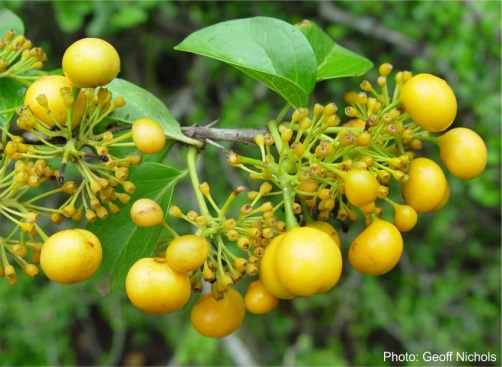
Description
Description
A shrub or small tree, 1–4 m up to 10 m high. Often multi-stemmed, well-branched. Bark smooth, brown to grey; spines 40 mm long, opposite along the branches. Young branches are pubescent to glabrous. Stipules interpetiolar, small, falling early (deciduous), part of the node covered by stipules have stiff hairs that persist after the stipules have fallen off. Leaves decussate, simple, elliptic, oblong to ovate, 15–50 × 10–50 mm, shiny dark green above, pale green, slightly discolorous below, glabrous or sometimes with short soft hairs on undersurfaces; nerves 2-4 pairs, looping near the margins; domatia (pits containing whitish hair tuffs) present in axils of primary lateral nerves on the lower surface; margins entire, undulate; petiole slender, 3–13 mm long, usually pubescent, grooved above. Inflorescences umbellate, paired in axils of leaves on young branches or shortened branchlets; peduncle 10–35 mm long, usually pubescent, with immature bracts in upper part. Flowers small, floral parts arranged in 4s. Corolla white, cream, greenish or pale yellow, 5–7 mm long, sweetly scented, during summer (Oct.–Mar.). Fruit a drupe, ±10 × 9 mm, fleshy, yellow, orange to red when ripe, shape variable and depending on the number of the seeds, but mostly kidney shaped, asymmetrically attached to the flower stalk, 1–3 seeds or sometimes 4 seeds, from midsummer to midwinter (Dec.–Jul.).
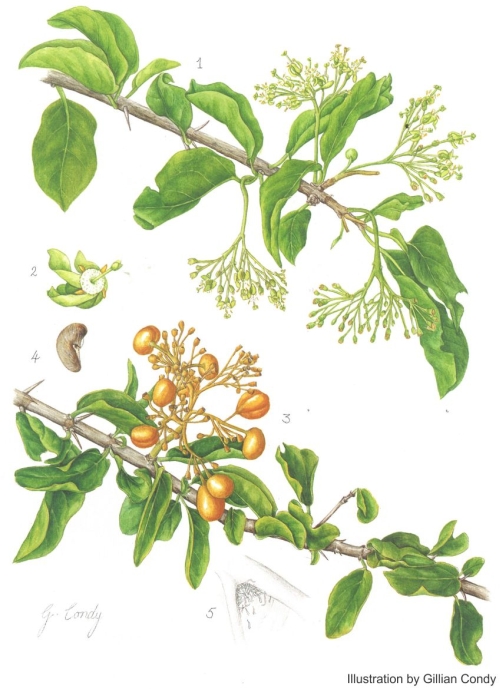
Conservation Status
Status
Distribution and habitat
Distribution description
The species is restricted to southern Africa where it occurs in interior and coastal areas in the provinces of Limpopo, Mpumalanga and KwaZulu-Natal in South Africa, as well as in Eswatini and Mozambique. It often grows on the hillsides or rocky ridges, but can also be found in sandy flats, riverbanks, dry watercourses and dune forests.
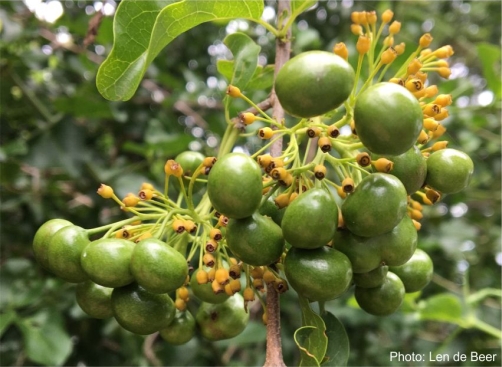
Derivation of name and historical aspects
History
This species was first classified in the genus Vangueria by Karl Schumann in 1899. During his monographic study of the tribe Vanguerieae in 1928, Walter Robyn created Plectroniella as a new genus after transferring Vangueria armata from the genus Vangueria. Plectroniella armata was identified as the sole species of the new monotypic genus Plectroniella. The genus name means ‘little Plectronia’, Plectronia was a genus that was previously associated with Canthium but is now obsolete. Cornelis Eliza Bertus Bremekamp in 1933 described Plectroniella capillaris as a new species of Plectroniella, separated from P. armata by its slender branches, short spines, herbaceous leaves and slender flowers stalks, but it was later thought to be a form of P. armata (Herman & Condy 1991) and is currently listed as a synonym of P. armata in world flora checklists.
A phylogenetic study of Vanguerieae by Lantz and Bremer in 2004 showed that Plectroniella armata is more closely related to the genus Canthium than Vangueria, and P. armata was transferred to Canthium. Subsequently, Verstraete et al. in 2013 reaffirmed Lantz and Bremer’s findings. However, this species is still known by the name Plectronia armata in numerous popular books on southern African trees. The genus name Canthium is the Latin form of kantankara, the Malayalam name in Kerala for Canthium coromandelicum, where kantan means ‘shining’ and kara ‘spiny shrub’. The specific epithet means ‘armed’ and it comes from Latin word armata and refers to the conspicuous spines.
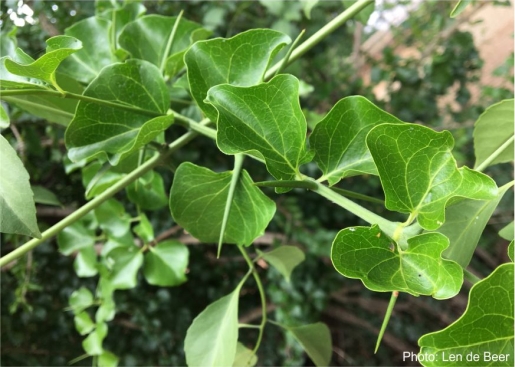
Ecology
Ecology
Birds eat the fruits (Boon 2010) and thus also disperse the seeds. Honeybees, solitary bees and long-horned beetles as well as Collared, Neergaard’s and Amethyst Sunbirds have been observed visiting the flowers (Geoff Nichols, pers. comm. 2023).
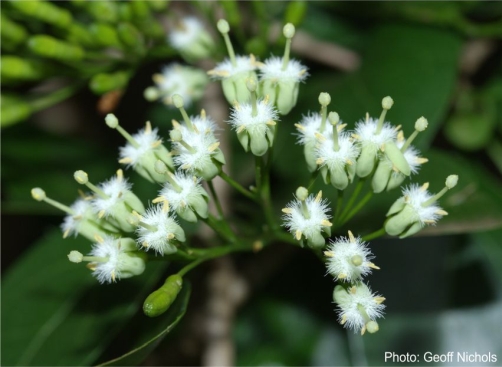
Uses
Use
People eat the fruits, which can also be used to make a jelly (Boon, 2010). Wood is used for construction and firewood, the leaves are also edible, and the sap is used to make beer in Eswatini. (Long, 2005). It makes a very good thorny barrier hedge, and can be trimmed to shape or left informal, and it is a good plant to grow to attract fruit-eating birds to the garden.
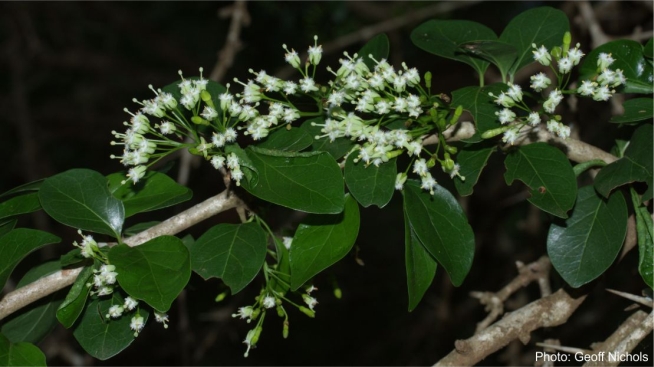
Growing Canthium armatum
Grow
Canthium armatum is relatively easy to grow from seed. Collect the fruits when ripe and remove the soft fruit that covers the seed and sow the hard, bow-shaped seeds as soon as possible after cleaning. Sow in spring or early summer and keep moist and warm. Germination should take 3-4 weeks. To improve germination, rub the seed coat on some rough sandpaper, this will let the water soak more rapidly into the seed. Use a 60-100 mm deep seed tray filled with a sandy soil mix e.g. 1:1 mixture of coarse river sand and fine leaf litter or compost. Leave the seedlings in the tray until the following spring and then transfer them, singly, into 500 ml pots or potting bags using a general soil mix with 10% by volume coarse river sand mixed in to improve drainage. (Geoff Nichols, pers. comm. 2023)
Grow in well-drained, sandy soil in sun or semi-shade. Plants will flower and fruit better in a sunny position. Canthium armatum has a medium growth rate. It is well suited to frost-free gardens in the summer-rainfall region and gardens in the bushveld, valley bushveld, thicket and sand forest biomes, and should be hardy to light frost.
References
- Boon, R. 2010. Pooley's trees of eastern South Africa, a complete guide. Flora & Fauna Publications Trust, Durban.
- Coates Palgrave, M. 2002. Keith Coates Palgrave Trees of southern Africa, edn 3. Struik, Cape Town.
- DeBeer, L. 2022. Observation of Plectroniella armata, Kruger National Park, Mpumalanga. iNaturalist. Online. https://www.inaturalist.org/observations/105107579.
- Herman, P.P.J., & Condy, G. 1991. Plectroniella armata. The Flowering Plants of South Africa 51(2): Plate 2029.
- Lantz, H. & Bremer, B. 2004. Phylogeny inferred from morphology and DNA data: characterizing well-supported groups in Vanguerieae (Rubiaceae). Botanical Journal of the Linnean Society 146 (3): 257-283.
- Long, C. 2005. Eswatini’s Flora – siSwati names and uses. Accessed via Eswatini National Trust Commission, http://eswatininaturereserves.com/flora/clfamilies.asp?fid=228.
- Palmer, E. & Pitman, N. 1972. Trees of southern Africa. Balkema, Cape Town.
- Plants of the World online. Plectroniella capillaris Bremek. https://powo.science.kew.org/taxon/urn:lsid:ipni.org:names:760798-1. Accesssed 06/01/2023.
- Pooley, E. 1993. The complete field guide to trees of Natal, Zululand and Transkei. Natal Flora Publication Trust, Durban.
- Quattrocchi, U. 2002. CRC World dictionary of plant names. CRC Press, New York.
- Tilney, P.M., Van Wyk, A.E. & Van der Merwe, C.F. 2012. Structural evidence in Plectroniella armata (Rubiaceae) for possible material exchange between domatia and mites. Plos One 7 (7): e39984.
- Van Wyk, B. & Van Wyk, P. 1997. Field guide to trees of southern Africa. Struik, Cape Town.
- Verstraete, B., Janssens, S., Lemaire, B., Smets, E. & Dessein, S. 2013. Phylogenetic lineages in Vanguerieae (Rubiaceae) associated with Burkholderia bacteria in sub‐Saharan Africa. American Journal of Botany 100(12): 2380-2387.
- Von Breitenbach, F. 1965. The indigenous trees of southern Africa. Department of Forestry, Pretoria.
- Von Staden, L. 2013. Canthium armatum (K.Schum.) Lantz. National Assessment: Red List of South African Plants version 2020.1. Accessed on 2023/01/03
Credits
Mulweli Maswoliedza
Compton Herbarium
March 2023
Acknowledgements: the author is grateful to Len de Beer for his willingness to share his iNaturalist photographs and Geoff Nichols for sharing his photographs and experience growing Canthium armatum.
Plant Attributes:
Plant Type: Shrub, Tree
SA Distribution: KwaZulu-Natal, Limpopo, Mpumalanga
Soil type: Sandy, Loam
Flowering season: Early Summer, Late Summer
PH: Acid, Neutral
Flower colour: Green, White, Cream
Aspect: Full Sun, Morning Sun (Semi Shade), Afternoon Sun (Semi Shade)
Gardening skill: Average
Special Features:
Horticultural zones








Rate this article
Article well written and informative
Rate this plant
Is this an interesting plant?
Login to add your Comment
Back to topNot registered yet? Click here to register.